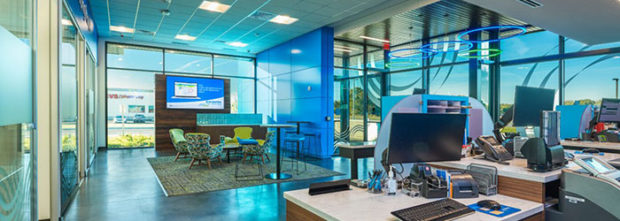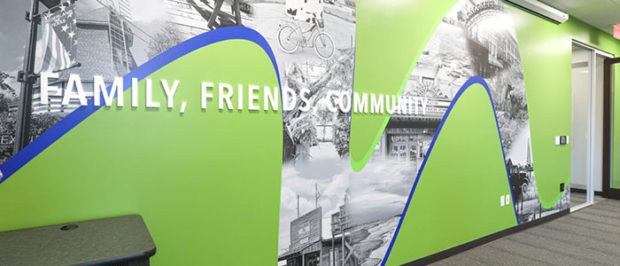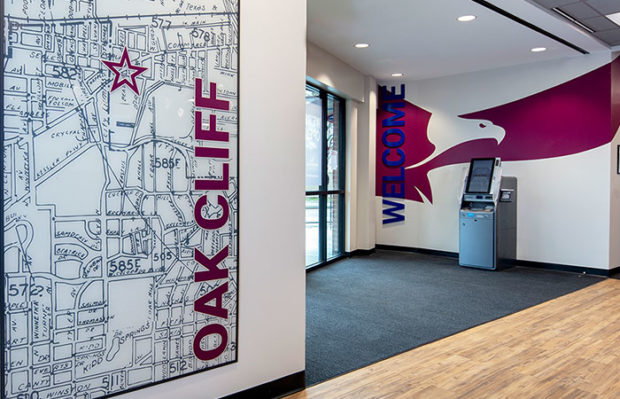What can make a bank branch feel creative and innovative in the digital age?
Kevin Brouillette would argue it comes down to environmental graphics, which he considers to be the future of branch design.
“The intent of environmental graphic design is to inform, captivate and delight a person within a space,” says Brouillette, the senior environmental graphic designer at NewGround, a branch design firm in St. Louis, Miss.
The term was first coined decades ago — as early as the 70s — he says. But the use of this approach in branch design has become a particularly prominent trend in recent years.
Brouillette says environmental graphics create a more welcoming environment, in contrast to the more formal feel older branches often have. This approach also allows banks and credit unions to incorporate their branding in a thoughtful and engaging way.
What is environmental graphic design?
Environmental graphic design — or EGD for short — is the use of graphic elements such as typography, color, imagery, and textures to curate and enhance the experience people have within a space, according to the design firm Hill & Partners. These elements are also frequently referred to as “experiential graphics.”
Julie Maggos, senior director of experiential design at IA Interior Architects in Chicago, says the use of environmental graphics is critical in modern retail design. Her clients often reach out to her with sophisticated ideas from brands such as Google or Target as they are working to develop their own concepts.
“It’s about the entire experience: the touch, the feel, the smell, the sound, everything in the environment,” Maggos says. “As part of the experience, our clients are understanding the value of including their brand and enhancing their culture within their work environment.”
Her team worked on BMO Financial’s headquarters in Chicago, shown below.
Here’s our interview with Brouillette, along with some examples of environmental graphic designs NewGround has deployed in bank and credit union branches.

Send the Right Offers to the Right Consumers
Achieve a better return on your marketing investment. Leverage behavioral data and analytics to target the right customers with the best possible offers.
Read More about Send the Right Offers to the Right Consumers

Unlocking Digital Acquisition: A Bank’s Journey to Become Digital-First
This webinar will offer a comprehensive roadmap for digital marketing success, from building foundational capabilities and structures and forging strategic partnerships, to assembling the right team.
Read More about Unlocking Digital Acquisition: A Bank’s Journey to Become Digital-First
Does ‘Environmental’ Translate to Outdoorsy?
TFB: Give us a crash course on environmental graphics.
Brouillette: A lot of people hear “environmental” and think these are designs that have something to do with going green or being outdoorsy. In recent years, the term “environmental” has evolved to “experiential,” which better reflects what it is that environmental graphic designers really create.
A quick example I use when someone asks me “what is EGD?” to help them visualize it: Picture walking into a Starbucks or McDonald’s. Think about the touchpoints, like exterior signage, digital, menus, logos, brand components, displays, messaging, etc. All those elements fall into the category of EGD.
Environmental graphics are essentially branded visual elements or communications that are brought to life in a physical environment. I like to describe it as the easily identifiable elements that help to directly brand a space. It encompasses a wide array of materials, finishes or even dimensionality.
EGD is a fusion of interior design with graphic design.
Neches Federal Credit Union: A Favorite Environmental Graphic Design Project
TFB: Tell us about one of your favorite examples of environmental graphic design among the financial institutions you’ve worked with.
Brouillette: One of my favorite projects all around was Neches Federal Credit Union’s new headquarters building in Port Neches, Texas.
The team there immediately understood the impact of adding environmental graphics to the new HQ space, and they were very collaborative and open to hearing ideas. We were able to celebrate things like their history, community, vision, and values in a big way to create a layered experience for their staff to enjoy in the new space.
Read more:
- Flexible Designs Help Future-Proof Bank Branches
- How Branding Pays Off in the Bottom Line and in Tough Times

What Are the Benefits of Environmental Graphics?
TFB: What do you enjoy about environmental graphic design?
Brouillette: One of the aspects I enjoy most is having the ability to work across all kinds of materials, dimensionality, and applications. It’s really rewarding to see an idea move from concept on screen to something in a real-life setting that people can enjoy.
I believe as a designer it is important to find something that you are truly passionate about and determine where you can make the most impact. For me, that’s been EGD so far in my career.

Images from the Oak Cliff branch of Neighborhood Credit Union, which is based in Dallas, Texas. Design by NewGround.
TFB: What are the biggest benefits for the banks and credit unions using this approach?
Brouillette:
- Environmental graphics can help create a truly engaging and inspiring space and add a layer of visual interest.
- They are a great way to celebrate a brand and foster a sense of belonging for people within a space.
- This allows people to feel a sense of connection within a space, similar to how we feel connections to brands. Think of how that translates to the built environment.
- Environmental graphics also can add a sense of delight to a space depending on the application.
Some of our larger, more involved programs are within flagship branches and especially HQ buildings.
Read more:
- Chase Defends Its Branch Strategy as Deposit-Gathering Machine
- See all of our most recent coverage on branches

What Else Should Bankers Know About Environmental Graphic Design?
TFB: What are the downsides? Are there any? Are there cases where it might not make sense for a bank or credit union to consider environmental graphic design?
Brouillette: If an organization intended to rebrand or refresh their brand, it would be essential to also refresh the EGD program.
EGD can be a great way to transform a space on a budget. It’s a lot more cost effective to refresh a built environment with EGD components compared to reconfiguring floor plans, adding architectural enhancements, or redoing finishes, etc.
Certain materials and applications can be utilized to avoid the need for large expenditures during a refresh process.
Integration of digital for certain components can also be a great way to avoid cost. We typically keep this in mind depending on what we discover from conversations with our clients.
I’ve worked across all sorts of mediums as a graphic designer, from print to digital, but environmental graphics quickly became something I was passionate about as my career progressed.
Want to learn more?
Kevin Brouillette is a member of the Society of Experiential Design, which he says is a great resource for any financial marketer who wants to know more about environmental graphics.

















